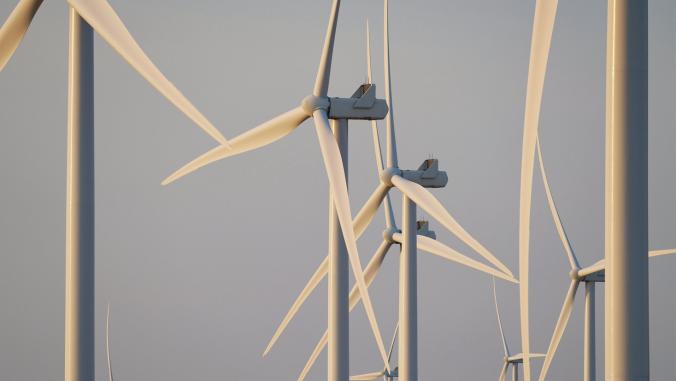Here's what it could take to accelerate Hawaii's transition to 100 percent renewables
The state is more than a quarter of the way to its 'all in' commitment to clean power, but the hardest work is yet to come.

Hawaii continues to make waves with bold commitments to a low-carbon future.
Its latest splash came in early May with a pledge to become carbon neutral by 2045 — the same deadline year as the one guiding the Aloha State’s unmatched 100 percent renewables goal.
There’s still an ocean of uncertainty about how to arrive at either destination, let alone how to map a route for the ambitious drive toward 100 percent clean ground transportation. But the vocal community championing Hawaii’s quest to wean itself off imported fossil fuels believes the state’s business and political leaders will find the resolve to move from the current mix of 25 percent renewables to that all-in aspiration. And it has plenty of suggestions about what it will take.
"Rather than being surprised by or unprepared for the changes to come, we have an opportunity now to take collective action and transition by design, not by default," wrote Dawn Lippert, CEO of Elemental Excelerator, in an April report detailing Hawaii’s progress. The Honolulu-based innovation accelerator was created 10 years ago by the Hawaii Clean Energy Initiative to support technologies or new business models that could accelerate the shift.
The report, released by Elemental Excelerator in collaboration with researchers Rhodium Group and Smart Growth America, outlines at least a half-dozen policy changes or incentive frameworks that Hawaii could embrace to speed things up.
One idea — a regulatory plan that makes it more financially attractive for utilities to invest in distributed generation resources and renewables — is already in progress. That policy directs the Hawaii Public Utility Commission (PUC) to overhaul the ratemaking structure (PDF) so that it rewards utilities for their performance along a number of metrics, including customer affordability and satisfaction, ability to provide access to granular information about energy usage and how quickly the utility can connect renewables and distributed energy resources (including those from third parties).The transportation commitment makes the electricity goal look like a piece of cake.
Right now, there’s little incentive for the Hawaiian Electric Companies to operate more efficiently, to conserve fuel, local clean energy advocates note. It’s still managing to shrink its dependence: according to the utility’s latest sustainability report, it used 8.55 million barrels of oil in 2017, compared with 10.7 million seven years ago. The company’s three operating companies — Hawaiian Electric, Maui Electric and Hawaii Electric Light — use renewables for 27 percent of their power needs, up from 26 percent in 2016 and on pace to hit the company’s 2020 target of 30 percent. But the new rate structure could speed things up.
"This is a critical piece of the puzzle, and we’re excited to see this measure cross the finish line," said Jeff Mikulina, executive director of Blue Planet Foundation, the 10-year-old Honolulu nonprofit that helped advocate for Hawaii’s 100 percent renewable portfolio standard. "This is the strongest signal yet of the intent to align the market with public interest. … Every other business on earth runs this way."
It will take at least 18 months for the specifics of this new policy to emerge (the deadline for implementation is 2020). One element to watch closely is how the islands deal with the accelerated retirement of fossil fuels plants that haven’t reached their useful life, noted Mark Glick, faculty and specialist on energy policy and innovation at the Hawaii Natural Energy Institute. (He was formerly administrator of the Hawaii State Energy Office.) "Dealing with that is one of the biggest deterrents moving forward," he said.
Another consideration: the emergence of new financial incentives and payment mechanisms, such as on-bill financing that would enable consumers or commercial accounts to invest in improvements, such as energy-efficiency technologies, without an onerous upfront cost, according to several experts interviewed for this update.There is no incentive for a hotel property or hospital to invest in a microgrid that can island itself.
When I caught up with Lippert in May, she noted that creating a framework for sharing data about energy consumption will be particularly important in encouraging the rise of private sector offerings that will help individuals and businesses get a better handle on their discrete consumption and how they get cleaner. "For accelerating the transition, I’m particularly glad to see the piece about data sharing," she said. "It will take a suite of measures to get things right. Most of all, we need flexibility."
These are some policies that will matter
While Hawaii’s community of clean energy advocates say the new performance-based regulation (which doesn’t apply to the state’s member-owned electricity cooperatives) is a big breakthrough, it has a slew of other suggestions for what’s needed to pull this off.
For example, while all of Hawaii’s mayors have vowed to support a move to 100 percent renewable ground transportation by 2045, no official state policy supports the adoption of zero emissions vehicles.
When I spoke with Honolulu’s chief resilience officer, Joshua Stanbro, at the commitment early this year (shortly after that goal was declared), he told me the counties are collaborating on their evaluation of potential technologies — such as electric buses — and on considering what interim goals might be useful. Meanwhile, his team with Honolulu’s Office of Climate Change, Sustainability and Resiliency is reaching out to private sector players, such as tour companies and fleet operators, to understand their long-term goals. "This will work out in an iterative fashion," Stanbro told me.
[Learn more about Hawaii's energy transition during VERGE Hawaii: Asia Pacific Clean Energy Summit, June 12-14.]
According to the April report on Hawaii’s progress, the transportation vision will require revisions to state and county land use policies to support multimodal options and make it less attractive to own cars. It also will require changes to parking management policies, including current laws that set minimums in new housing developments, as well as new designs for public streets that better accommodate pedestrians, bicycles, buses, rail options, electric vehicle charging and car sharing services.
The transportation commitment "makes the electricity goal look like a piece of cake," in part because so many constituents must be consulted and engaged to achieve it cost effectively, Glick said.
Financing is a significant wild card, as the transportation agency is funded by gasoline taxes, and the investment scenario becomes more complicated when you consider that some zero-emissions commitments on the mainland United States have been linked to national air quality standards and have received some funding related to mitigation.Hawaii already has the second highest rate of electric vehicle adoption in the United States.
"For transportation, we have a lot of work to do if we want to build that market," Mikiluna said.
One key private-sector player in this transition is likely to be the state’s car rental fleet operators, as many of those vehicles eventually find second homes with private owners. By requiring those fleets to include EVs, the turnover could happen more quickly.
For perspective, Hawaii already has the second highest rate of electric vehicle adoption in the United States, with about 7,000 EVs registered, according to figures cited by Hawaiian Electric. The utility has filed a plan with the state’s PUC outlining its "electrification of transportation" roadmap, which describes future in which Hawaii will be home to the "most personal light duty vehicles" powered by soar, wind, biofuels, geothermal or other renewables.
Hawaiian Electric is working with automakers to reduce the purchase price for EVs, and it hopes to partner with third-party charging networks to build out a network of utility owned charging stations (including fast chargers). Like many other utilities investing in EV charging infrastructure, it foresees offering future demand response services to EV drivers.
And what of that recent carbon neutrality pledge? It’s a good aspirational goal, but no concrete penalties are associated with falling short, said Kyle Datta, general partner of investment firm Ulupono Initiative.
A carbon tax, for example, could generate revenue to help fund clean energy projects, watershed restoration and other projects that could shore up the state’s water sustainability. While one isn't in place at this time, a second bill passed in May lays the groundwork for the creation of a carbon offset program.
A call for creative approaches to financing
Pretty much everyone agrees that energy storage technology will be crucial for helping Hawaii reach its 100 percent renewables goal: Hawaiian Electric alone has at least 17 projects under way, and in early May it proposed two more systems with a combined capacity of 120 megawatts. The utility is taking advantage of a 30 percent federal investment tax credit to help pay for this investment.
Right now, even though Hawaii offers plenty of incentives meant to help homeowners and businesses invest in renewables or energy efficiency, the state doesn’t offer incentives for energy storage installations. The legislature has considered various bills over the past several years but hasn’t managed to pass any of them.
That’s a big hole, according to Mikiluna, because that component is necessary for the development of more renewably powered microgrids across the islands. "There is no incentive for a hotel property or hospital to invest in a microgrid that can island itself," he said.
Another consideration that doesn’t get enough attention or funding is the work that must be done to modernize the electric grid, so that outages are more isolated during times of natural disasters, Datta said.
The severe flooding on Kauai in April and the fresh eruptions at the Kilauea Volcano on Hawaii (which forced the shutdown of a geothermal plant) serve as reminders of how vulnerable certain communities are to disruptions. And the damage to solar and wind farms from Hurricane Maria in Puerto Rico should convince renewables developers to look more carefully at siting considerations, Datta said. "We can see what happens when you do it wrong," he said.





